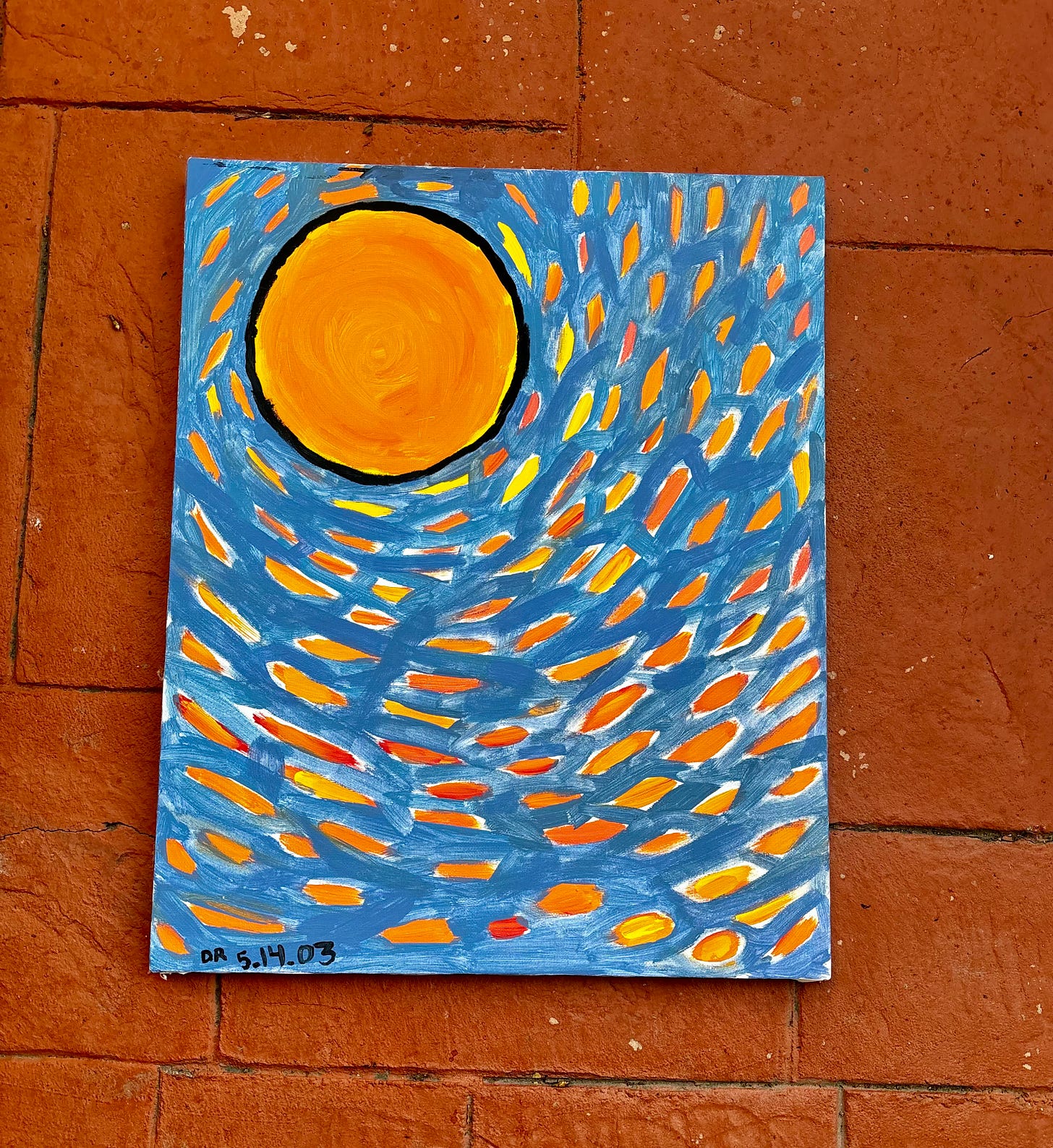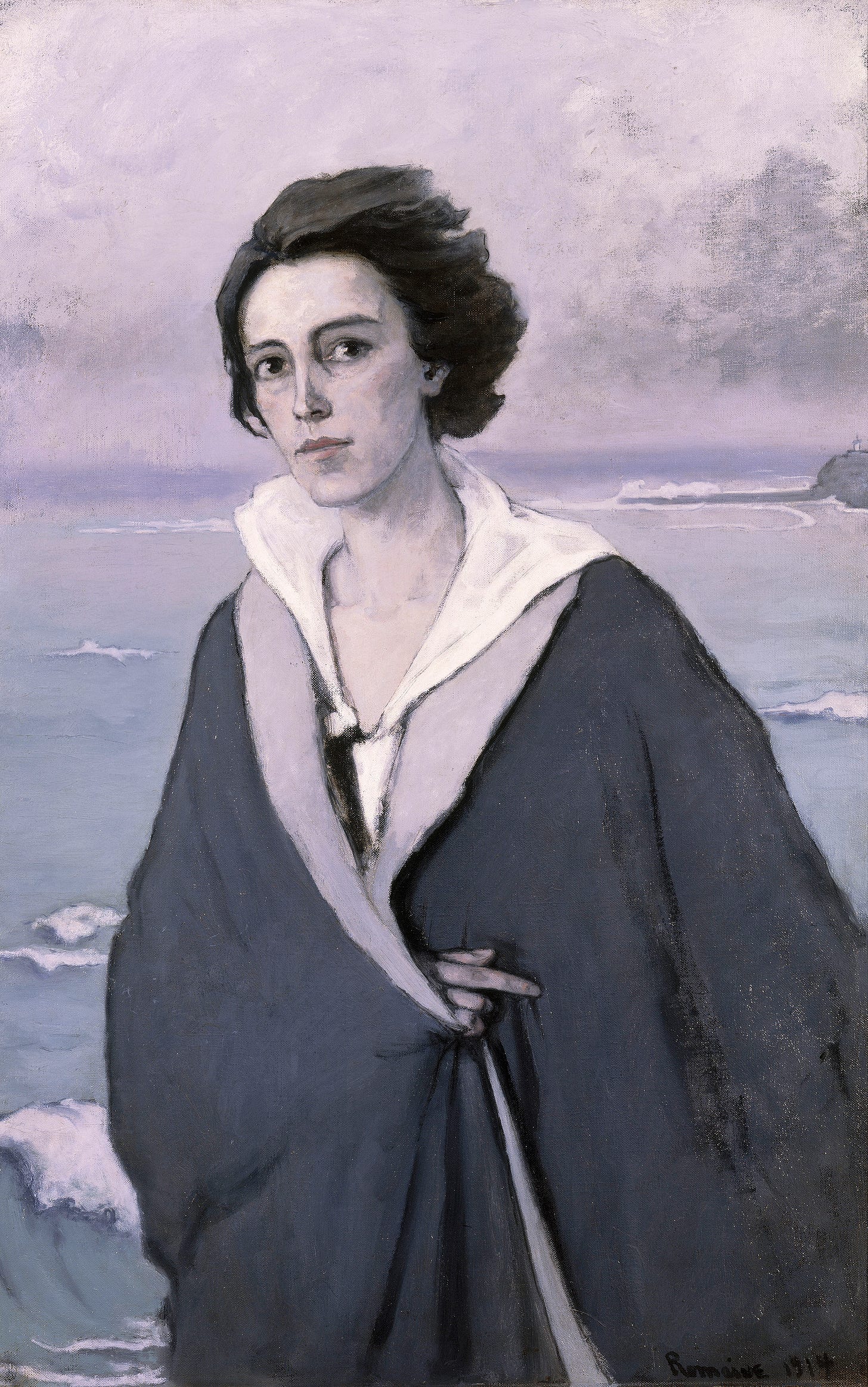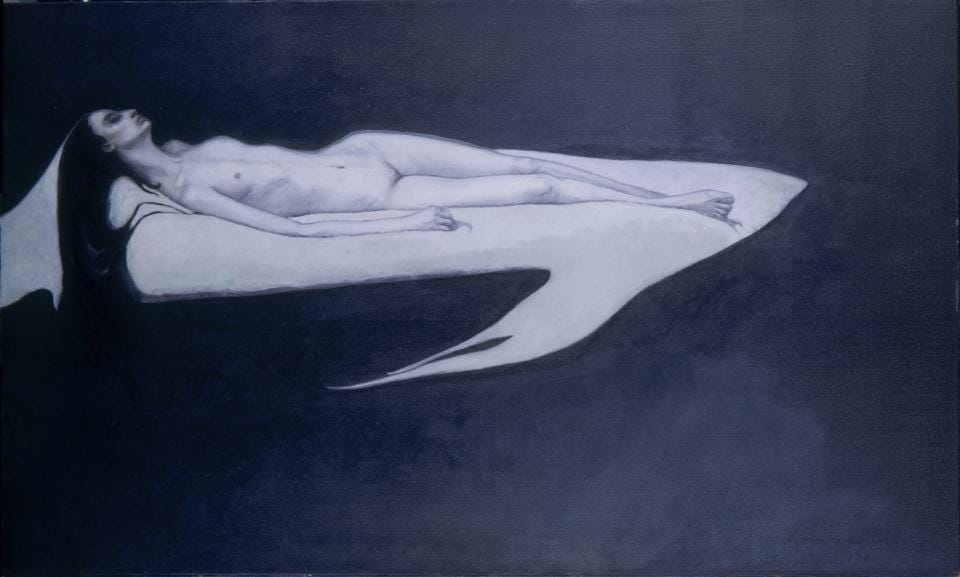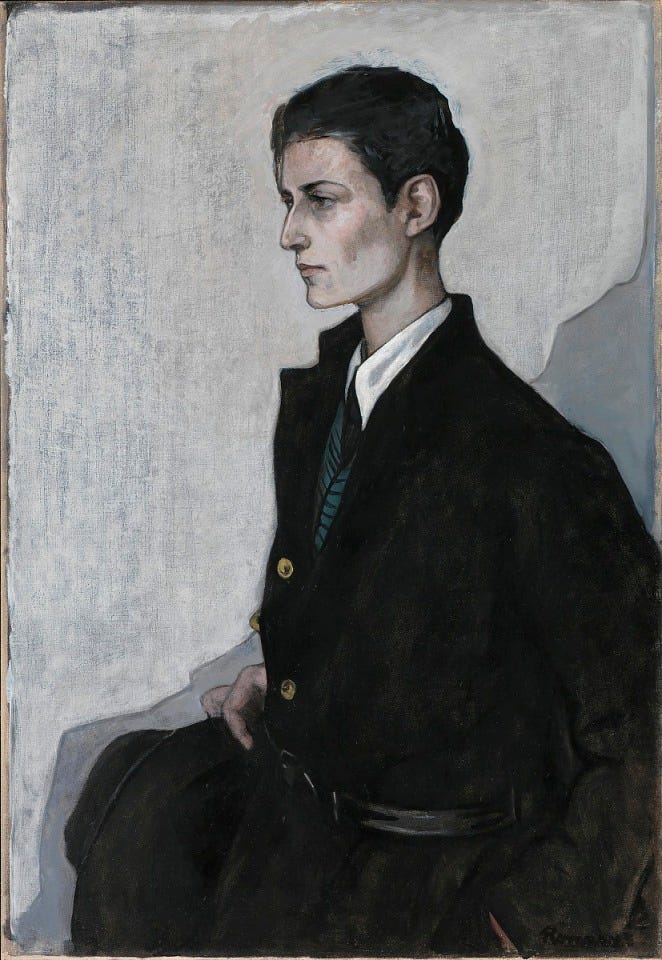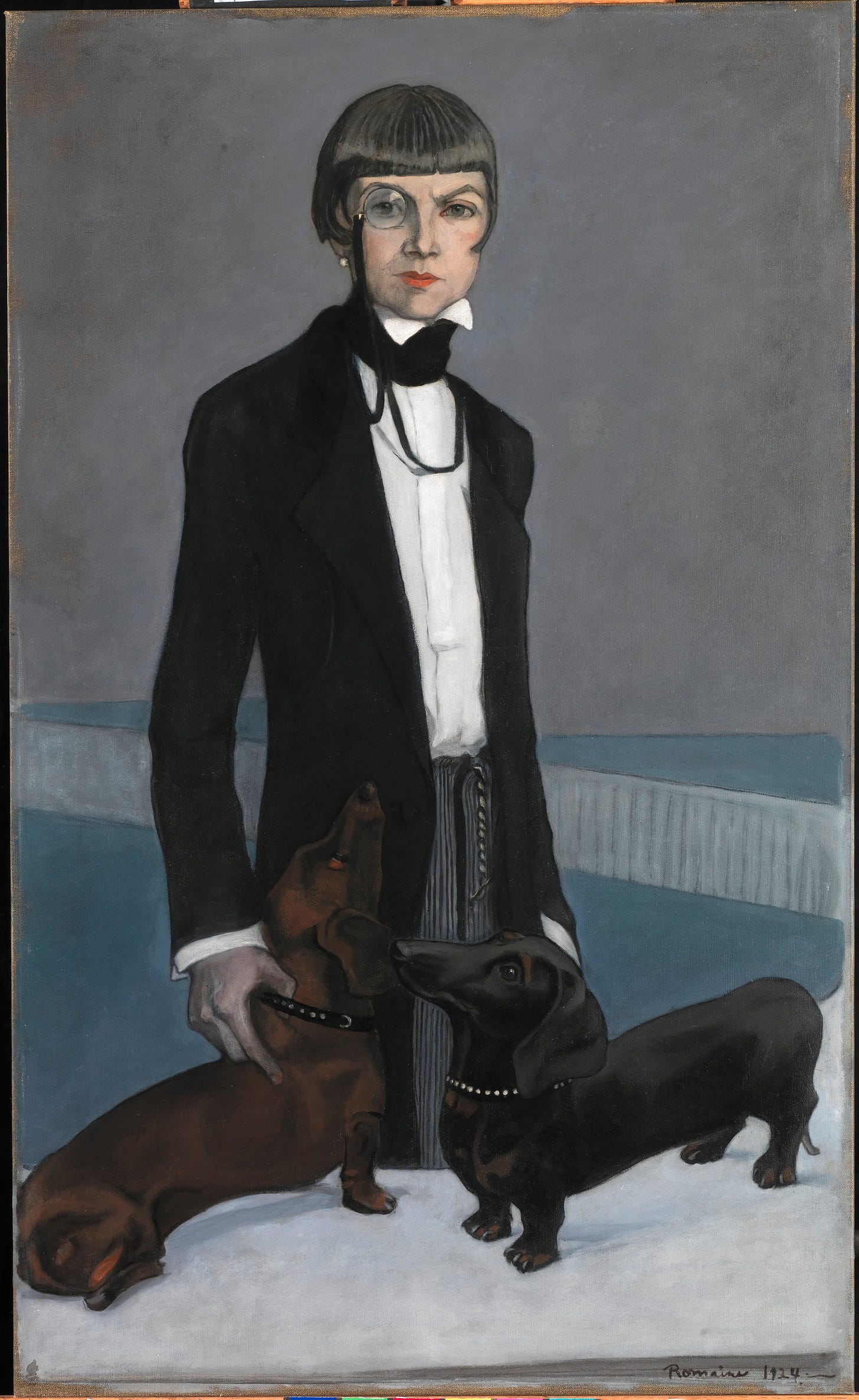Listen To Take Your Time
Here is the audio version of Take Your Time #17. Enjoy!
Illustration
In honor of the summer solstice, the day of the year with the longest period of sunlight, I wanted to share this painting of the sun I did 21 (😳) years ago. Thank you to my mom for hanging on to this painting (and so many others) and for taking a picture of it for me!
Inspiration
I’m drawn to the works of visionary LGBTQ+ artist Romaine Brooks (1874-1970). Her portraits of women, including her powerful and revolutionary self-portrait, defied traditional gender roles and expectations of 1920s, and connect to people today who admire, “…her strength, her journey, her vulnerability, and her honesty.” Stylistically, her work is genre-bending and touches on surrealism, realism, symbolism, the Aesthetic Movement, and traditional portraiture. Her limited and focused color palette of white, grays, and black pulled me into her work. I recently did a value scale exercise, where we had to paint a scale from the lightest value (white) to the darkest value (black). The assignment made me understand that there is an infinite range of values between white and black. Having done this practice myself makes me appreciate what a master of color and value Brooks is and how the limited palette is quite boundless and freeing.
Brooks lived a life of great privilege, yet it was marred by tragedy. She began painting before women had the right to suffrage. Though she and her sister eventually inherited great wealth from her coal-baron grandfather, she was abandoned by her father and abused and then also later abandoned by her mother. She lived and painted in New York City, New Jersey, Paris, and eventually Capri, a haven for LGBTQ+ people, before moving to London, and Nice. She lived a fascinating, admirable, and inspired life.
The androgynous women in her paintings seem to know themselves well; they have strong, asserted identities and are self-possessed, calm, and confident. They defy expectations in every way, from clothing (or lack of clothing) to the way they wear their hair and even where they gaze. They have the strength and confidence to be themselves and express themselves in a way that can still be hard to do now, and I think that is a big reason why her work resonates today and should be seen by more people.
“I grasped every occasion no matter how small to assert my independence of views. I refused to accept the slavish traditions in art, and though aware it would shock I insisted on marking the sex-triangles of all my female nude figures. The traditional depilatory effect shocked, me, and I discarded it altogether.” - Romaine Brooks
“I suppose an artist must live alone and feel free otherwise all individuality goes. I think of painting only when I am alone, even less do any actual work.” - Romaine Brooks
“We are what we can be, not what we ought to be.” - Romaine Brooks
Ideas
“Art, it’s a magic wand. But you need to believe, and you need to take the time to see what it will do,” said Eman Elsayed, who moved from Egypt to Leeds, England, and joined the Kuluhenna Creative Workshop, an art, theater, and dance workshop for women in the local area with a special focus on refugees and asylum seekers who moved to the area. Art can be healing, empowering, and uniting, and the article Tapping Art’s Power to Heal Wounds and Open ‘Spaces of Connectedness’ shows how groups and people around the world use art to build community, give people a sense of agency, inspire positive social change and even build peace. Art can transcend barriers, be a powerful connecting force, and should not be underestimated.
A highly influential medium that shapes children's and parents’ lives and ways of thinking is picture books. As I continue to try to publish “Maybe Scooter” and work on a second picture book, I always like to learn more about authors and illustrators of picture books. Armenian illustrator Nonny Hogrogian died recently at the age of 92 and is a two-time Caldecott Medal winner. See this read-along of one of her winning stories and note how much the fox inspired my title character Scooter.
In her acceptance speech after receiving her first Caldecott, Ms. Hogrogian described her thought process in deciding how to illustrate “Always Room for One More,” based on a Scottish folk song about a poor man who keeps welcoming guests into his home.
“Woodcuts, long my favorite medium, were too strong for the gentle folk in the heather,” she said. “So I pulled out my watercolors and chalks, some ink and a pen, and before long, in an almost effortless way, the drawings seemed to flow.”
And lastly, I haven’t shared a song in a while, but I came across this one and fell in love with it. This is Sam Phillips, who you may know from some of the wordless transition music from Gilmore Girls, but also has been making albums since the 80s and has a warm but whistful baroque-pop sound. This song is from the 90s but sounds timeless.
Ending Quote
The summer solstice was a few days ago. It’s officially summer. Here’s a poem by Mary Oliver called The Summer Day:
Who made the world?
Who made the swan, and the black bear?
Who made the grasshopper?
This grasshopper, I mean—
the one who has flung herself out of the grass,
the one who is eating sugar out of my hand,
who is moving her jaws back and forth instead of up and down—
who is gazing around with her enormous and complicated eyes.
Now she lifts her pale forearms and thoroughly washes her face.
Now she snaps her wings open, and floats away.
I don't know exactly what a prayer is.
I do know how to pay attention, how to fall down
into the grass, how to kneel down in the grass,
how to be idle and blessed, how to stroll through the fields,
which is what I have been doing all day.
Tell me, what else should I have done?
Doesn't everything die at last, and too soon?
Tell me, what is it you plan to do
with your one wild and precious life?





